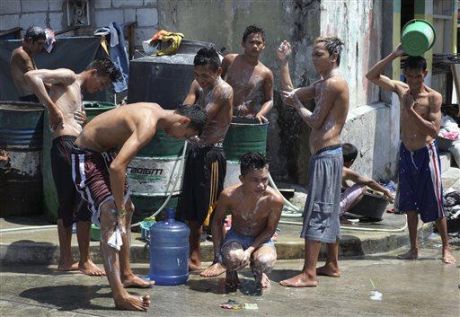Literally. And this heat is attracting a lot of political heat as well. It is one of the biggest ‘concerns’ aired by the recent set of high-profile senatorial jailbirds about their new accomodations in Camp Crame. A lack of airconditioning to alleviate the oppressive heat there is finally getting a bit of air time (pardon the pun). In the Philippines you’re pretty much a sweathog without airconditioning — even lying still in the middle of the night does not prevent sweat beads from forming on your forehead and matted hair. There’s just no escaping the Philippines’ year-round heat and the accompanying withering humidity without spending the big bucks.
And it is going to get worse. Metro Manila is already recognised as the planet’s most-densely populated megalopolis. More and more Filipinos are being packed into smaller and smaller spaces every year as population growth gallops along at embarrassingly high Catholic rates and employment opportunities evaporate in the environmentally-degenerating hinterlands. Even the dead share space with tens of thousands of warm Filipino bodies in Manila’s decrepit public cemeteries!
With more gleaming malls sprouting up every day, each equipped with rocket-fuelled airconditioners moving thousands of tonnes of moist heat from inside their trendy boutiques out into the faces of sun-beaten Metro Manilans, Manila will really be seeing its mercury rising to stratospheric levels in the coming years! That’s good news for the Philippines’ entrenched oligarchy whose members monopolise manufacture, importation, and distribution of household and industrial cooling equipment, not to mention the old Spanish clans that control generation of the electricity guzzled by these monstrous machines. Indeed, the new rich in chi-chi Dubai are making more and more of their fossil-fueled money off the misery of heat-beaten tropical folk. Some folk have the smarts to make money off the heat and some have the money to beat the heat. Unfortunately for the average Filipino schmoe, most people only have their pamaypays.
| SUPPORT INDEPENDENT SOCIAL COMMENTARY! Subscribe to our Substack community GRP Insider to receive by email our in-depth free weekly newsletter. Subscribe to our Substack newsletter, GRP Insider! Learn more |

There are solutions available beyond airconditioning, believe it or not. But it involves large-scale and long-term thinking. According to Scientific American the answer to the question of how best to sustainably cool steaming cities like Manila is through the application of climate responsive design in urban development.
[…] researchers modeled how the three cities would respond to a minimum green space ratio on land parcels, setting a floor for areas covered with grass, gardens or trees. Vegetation tends to have a cooling effect by circulating moisture in the air that draws away heat during evaporation. Tree canopies also provide cooling shade.
The team also modeled how Phoenix, Philadelphia and Atlanta would behave with more reflective streets, sidewalks, parking lots and rooftops. Higher reflectivity, or albedo, means the area absorbs less sunlight, thereby lowering the temperature.
Stone and his collaborators then overlaid a health impact model. They found that combinations of increased vegetation and albedo could cut into projected increases in heat deaths, reducing them between 40 and 99 percent. “On average, we reduced the rate of increase by about 60 percent,” [Brian Stone Jr., an associate professor of city and regional planning at the Georgia Institute of Technology] said.
The challenge of getting good enough solutions implemented in Manila is balancing the interests of the city against the private interests of big and small businesses that keep it humming along. Most Metro Manilans feel the full impact of heat primarily when they are stuck sweating it out in the metropolis’s notorious hours-long traffic jams, yet many of the solutions to Manila’s infernal traffic are obvious and easy to implement. The trouble lies in what to do with the millions of impoverished Filipinos who will be temporarily marginalised by these obvious solutions. Because Manila’s teeming colonies of poor folk are lovingly cultivated by Filipino politicians for their votes, there is little hope of the right arguments essential to getting obvious solutions implemented ever winning.
There is ample land all over Metro Manila to build sprawling parks with climate-cooling vegetation. Trouble is, only the private sector possesses the financial resources to eradicate the millions of squatters that infest these spaces. And even with those awesome resources, they will still need the blessings of vote-hungry politicians to secure permission to do just that.
That means Metro Manilans are pretty much stuck. Stuck in traffic. Stuck in the heat. Stuck with the hot air of their leaders.
- The ultimate theory on why woke people are such mental cases - January 10, 2026
- The curious case of Filipino communists’ condemnation of the US attack on Venezuela and their support for Nicolás Maduro - January 6, 2026
- The Philippines needs to implement a total ban on access to social media apps for ALL ages! - January 3, 2026
In manila, the wind doesn’t blow, it sucks.
Philippines hate development and change. Pinoys don’t like science. They love magic, superstition, and mind corruption. Tell them to make difference and they’ll laugh at you. Give them a measly 10 peso coin and they’ll fight for their politicians ’til death. That’s how degraded pinoy pride is.
Yes, it is a disgraceful situation.The fact is they should lynching these depsotic scumbags.
Let the Thieves fry in their cells at Camp Crame. The trees around Metro Manila are already cut down. All you can see is denuded landscape. Metro Manila is full of Squaters and their shanties, made of garbage materials.
Pollution is also contributing to this abnormal climate. The Ocean is warming…so it dissipates more heat.
its too bad that Manila will NEVER implement anything resembling the plans that may go into effect in U.S. cities….they just will not do it.The politicians stay in Manila as little as possible and then they are all in Air-con cooled comfort 24/7.
DREAM ON!
Design? You want Filipinos to DESIGN something?
Well, we can but hope.